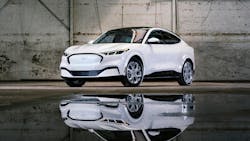When you first learned about what was needed to provide tire service, the list of equipment was simple: a good tire mounting machine, a balancer, an alignment rack and the tools needed to make the adjustments. Tire sizes changed over the years, so new machines were needed for wider and larger diameter wheels. With a few exceptions, the equipment could handle almost any consumer tire and wheel combination.
Just like today, training was often provided by the company that sold the equipment. In recent years, we’ve seen the rise of the internet and video training and who knows what artificial intelligence will bring?
As you well know, getting what you need to open a well equipped tire store today is more capital-intensive. And big investments need a large car count to make a profit. With that mindset, how does hybrid and pure electric vehicle (EV) service compare in the training and equipment space? We will talk about training first and then tooling at the end of this column.
If your store is already servicing and repairing gas-powered cars and trucks, you have a lot of the equipment you need now.
If one or more of your techs are ASE-certified in all eight areas, known as a master-level technician, then you are well down the road to offering full service to hybrid owners. That is not the case if you want to add plug-in electric cars and light duty trucks. This requires more training and equipment.
The training needed for hybrids and plug-in EVs starts with high-voltage system safety. A free YouTube video may not make your technician feel safe. A hands-on class that allows the tech to do the work alone, with supervision and the proper personal protective equipment (PPE), will give the tech the confidence needed to keep going to school. Not only will they be safe from high voltage shocks, they will also learn about high-voltage power flow.
The approach is to keep everyone safe. Once their fear is gone, deeper learning can begin.
As with all modern vehicle systems, the learning never ends.
If you stay with just hybrids, the technology has had 25 years to advance, so not all is new. For example, if you have been trained on Hyundai/Kia hybrids, the basic idea from model year 2011 to now is very similar within those brands. Honda is not the same as Toyota, but Ford is. Volkswagen and Audi share lots of parts. General Motors does its own thing in the hybrid world. Some OEMs have given up hybrids and have gone all-EV.
The brands you want to take on should be the hybrids and EVs that sell well in your part of the country.
When it comes to EVs, the transition may be harder. It will require more training in heating the cabin and charging the battery pack. Tesla EVs do not conform to any norms. Having never built an internal combustion engine-driven vehicle, all the OBD regulations never applied to Tesla, so they did what they wanted.
Even the language Tesla uses is new is some ways.
The learning curve on EVs can be steep. No more miles per gallon. Now, it’s kilowatts per mile. MPGe is “miles per gallon equivalent.” The old question, “How large is your gas tank?” is now “How many useable kWh do you have?”
The EV service skill set includes mastery of electrical systems, the ability to read complex wiring diagrams and using scope patterns to find irregularities. As I explain in my class, you will need to move up from being a technician into being what I call “a self-taught engineer.”
The EV segment is new and ever-changing as EV manufacturers keep trying new things. The high-voltage battery pack is still under development to make it safer, lighter and less expensive. Parts that were also used on hybrid cars are mature.
But to make a car run on higher voltages and drive farther and make it all work in sub-zero temperatures is not an easy thing to do. When it comes to equipment, start with all the PPE and other safety-related products. If you have a well-equipped shop doing repairs now, mainstream hybrid technical information is included in your subscription. Most aftermarket advanced scan tools will work for 90% of what you need. There are many fast, four-channel digital oscilloscopes. The digital voltmeters you own must be CAT III-rated to 1,000 volts.
Hybrids are also where the profit is. EVs will require charging equipment and more tooling. The most logical way to know what to buy is to get trained at a company that owns all the equipment so you can use it and see what you have and what you will need.
What are you going to do?
About the Author

Craig Van Batenburg
Craig Van Batenburg is MTD's monthly EV Intelligence columnist and the owner of Van Batenburg's Garage Inc. dba Automotive Career Development Center, which provides training for facilities that service - or want to service - electric and hybrid vehicles. For more information, see www.fixhybrid.com or email Craig at [email protected].
